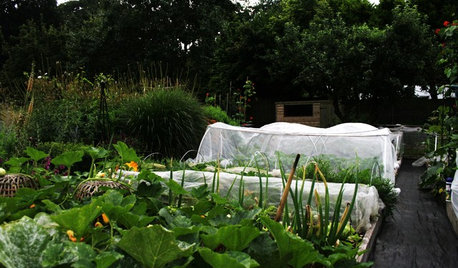U of F with an experiment in my yard
shavedmonkey (Harvey in South Fl.)Z10b
10 years ago
Related Stories

LIFEThe Good House: An Experience to Remember
A home that enriches us is more than something we own. It invites meaningful experiences and connections
Full Story
EDIBLE GARDENSFood and Community Thrive in a U.K. Allotment Garden
Get a peek at a rented garden plot in England where edibles and flowers mix and local residents can mingle
Full Story
LIFEIs Cabin Fever Real? Share Your Story
Are snow piles across the U.S. leading to masses of irritability and boredom? We want to hear your experience
Full Story
TREESGreat Design Plant: Southern Magnolia, Iconic U.S. Native
Massive, fragrant blooms and deep green leaves set Magnolia grandiflora apart from other large shade trees
Full Story
ARCHITECTURERoots of Style: Ranch Architecture Roams Across the U.S.
Great remodeling potential and generously spaced sites make ranch homes ever popular. Is one of the many variations right for you?
Full Story
GARDENING GUIDESDo You Have This Invasive Plant in Your Yard?
Garlic mustard is spreading across the U.S. Here’s how to spot it and what to do
Full Story
EVENTSSpring Tour: Landscape Designs for Living
Northern California yards in a spring garden tour show that landscape design is all about the experience
Full Story
GARDENING GUIDESHow to Find the Right Native Plants for Your Yard
Find plant maps, sale sites and guides that make going native in the garden easier than ever
Full Story
MOST POPULAR5 Ways to Hide That Big Air Conditioner in Your Yard
Don’t sweat that boxy A/C unit. Here’s how to place it out of sight and out of mind
Full Story
COMMUNITYBook It: Bring a Mini Library to Your Front Yard
Take a book, leave a book. An ingenious lending-library idea is sweeping the nation — see if it's right for your neighborhood
Full Story







Michael AKA Leekle2ManE
shavedmonkey (Harvey in South Fl.)Z10bOriginal Author
Related Professionals
Doctor Phillips Landscape Contractors · Federal Way Landscape Contractors · Mason Landscape Contractors · Norristown Landscape Contractors · Porterville Landscape Contractors · San Carlos Park Landscape Contractors · Palos Heights Landscape Contractors · Coatesville Decks, Patios & Outdoor Enclosures · Dedham Decks, Patios & Outdoor Enclosures · Rocklin Decks, Patios & Outdoor Enclosures · Pleasant Grove Decks, Patios & Outdoor Enclosures · Laurel Siding & Exteriors · Colorado Springs Siding & Exteriors · Kennewick Siding & Exteriors · Milwaukee Siding & Exteriorsshuffles_gw
Michael AKA Leekle2ManE
zzackey
cocoabeachlorax
saldut
beachlily z9a
shavedmonkey (Harvey in South Fl.)Z10bOriginal Author
shuffles_gw
msmorningsong
pnbrown
dlsm
shavedmonkey (Harvey in South Fl.)Z10bOriginal Author